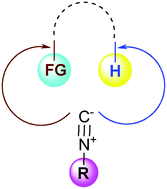Metal-catalyzed C–H functionalization involving isocyanides
Abstract
Isocyanides have a broad range of applications in multicomponent reactions such as Passerini and Ugi processes. Recent advances in metal catalysis have tremendously increased the versatility of isocyanides in organic chemistry. Suitable metal catalysts could selectively activate various C–H bonds to allow direct functionalization under mild conditions, which represents a chemical process with broad synthetic potential. The synergy from the combination of isocyanide insertion and C–H bond activation offers an efficient and powerful tool to establish complicated reactions and to construct useful substances, from which the high potential of such strategy has been convincingly demonstrated in drug discovery, organic synthesis, and materials science. The present review highlights the most recent advances of isocyanide chemistry in metal-catalyzed C–H bond functionalization.


 Please wait while we load your content...
Please wait while we load your content...